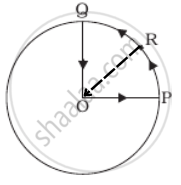Advertisements
Advertisements
प्रश्न
A cyclist starts from centre O of a circular park of radius 1 km and moves along the path OPRQO as shown figure. If he maintains constant speed of 10 ms–1, what is his acceleration at point R in magnitude and direction?

उत्तर
According to the problem, the path of the cyclist is OPRQO.

The cyclist is in uniform circular motion and it is given that linear velocity = 10 m/s, R = 1 km = 1000 m. As we know whenever an object is performing a circular motion, acceleration is called centripetal acceleration and is always directed towards the centre. So cyclist experiences a centripetal force (acceleration) at point R towards the centre.
The centripetal acceleration at R is given by the relation, `a_c = v^2/r`
⇒ `a_c = (10)^2/1000`
= `100/10^3`
= 0.1 m/s2 along RO.
APPEARS IN
संबंधित प्रश्न
For a particle performing uniform circular motion `vecv=vecomegaxxvecr`obtain an expression for linear acceleration of the particle performing non-uniform circular motion.
Is it possible to have an accelerated motion with a constant speed? Explain
Differentiate between uniform linear motion and uniform circular motion.
If a particle moves with uniform speed then its tangential acceleration will be ______.
A particle goes round a circular path with uniform speed v. After describing half the circle, what is the change in its centripetal acceleration?
The ratio of angular speed of a hour-hand to the second-hand of a watch is ____________.
Earth can be thought of as a sphere of radius 6400 km. Any object (or a person) is performing circular motion around the axis of earth due to earth’s rotation (period 1 day). What is acceleration of object on the surface of the earth (at equator) towards its centre? what is it at latitude θ? How does these accelerations compare with g = 9.8 m/s2?
A disc of radius 5 cm rolls on a horizontal surface with linear velocity v = 1`hat"i"` m/s and angular velocity 50 rad/s. Height of particle from ground on rim of disc which has velocity in vertical direction is ______ cm.

The distance of the Sun from earth is 1.5 × 1011 m and its angular diameter is (2000) s when observed from the earth. The diameter of the Sun will be ______.
The acceleration of a point on the rim of a flywheel 1 m in diameter, if it makes 1200 rpm is ______.
